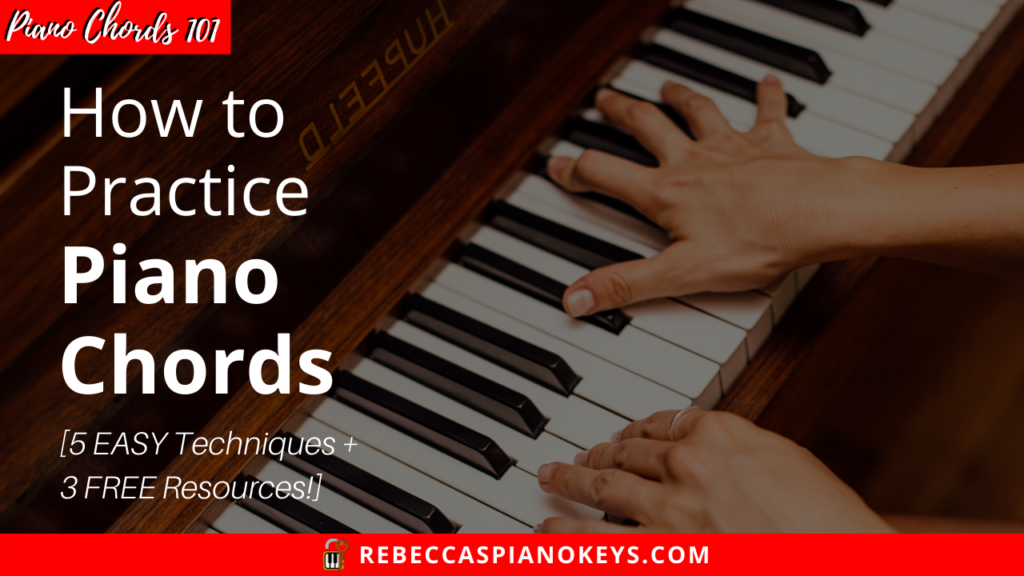Last Updated on March 22, 2023 by Rebecca
Learn 6 EASY strategies to help you practice piano chords so you can play chords with improved speed, accuracy, and confidence!
In a previous post, I explained how to build the 4 types of triads (major, minor, diminished, and augmented), and where you should start as a beginner.
Specifically, I suggested you start with the following 4 chords: C, F, G, and Am. (This post about the I-V-vi-IV chord progression explains why.)
But how exactly are you supposed to practice these 4 chords so you can develop the ability to play them confidently, fluidly, and effortlessly?
That's where this post comes in!
Keep reading and you'll find tips, tricks, and free resources to help you practice and improve your piano chord skills.
Now let's get started so you can get over to your piano ASAP and start practicing!
No time to read the strategies now? Pin this post for later!

1. Worksheets
I know, I know. Worksheets seem so old-school. But to be honest, I'm a big fan of old-school.
Worksheets are great because they allow you to chunk your learning process. And when it comes to learning, chunking is your friend!
There are a lot of different way to chunk your learning, but at it's core, chunking just means breaking big tasks into smaller tasks and focusing on only one task at a time.
And worksheets are an excellent way to chunk your piano learning. They allow you to gain some confidence and mastery in the mental/theory side of things before you start trying to apply that theory to the physical/practical side of things.
Is it necessary to master the theory before you start practicing it? No. You could learn the theory by playing your chords. In fact, playing the chords is an excellent way to master the theory.
But, trying to do it all at once can be overwhelming for a beginner.
Which is why we chunk with worksheets!
You can use worksheets to wrap your head around what the chords are supposed to look like. That way, when it's time to start playing the chords, your brain already knows what to tell your hands to do. Which means less processing time and less frustration when you're actually at the piano.
It also means more accuracy at the piano… and whenever you're building muscle memory (which is basically always when it comes to piano practice), accuracy is your number 1 goal, above all else.
These free worksheets will help you become familiar with the C, G, F, and Am chords on the piano.
2. Flash Cards
Yes, I'm going old-school again. And I'm sure there's an app that can do the same thing as flash cards. But it's nice to be able to unplug sometimes!
Flash cards are great because they can be used at the piano, and away from the piano. So you can use them to practice your chords while you're on the go. (You're not stuck in traffic, you're practicing piano!)
These free piano triad flash cards have chord diagrams on one side, and chord symbols on the other side. All you have to do is download them, print them double-sided, cut them out, and let the learning begin!
They even come with some tracking sheets! (More on that below!)
Here are 3 ways you can use these flash cards:
- You can use the diagrams side to practice recognizing and naming chords.
- You can use the symbols side to practice naming the chords represented by the symbols, as well as the 3 notes that make up that chord.
- You can use the symbols side to practice playing the chords represented by the symbols.
3. Visualization
Visualization is a musician's best friend. And I don't mean this in the “positive mindset/manifest your success” kind of way. I mean it in a very literal sense.
When practicing piano, you're building muscle memory and neural pathways. And these 2 things rely on repetition. More specifically, they rely on accurate repetition.
I always explain this with a trail-breaking analogy. When you're breaking trail through dense jungle, you need to follow the same exact trail several times in order to beat it down.
If you follow a different trail each time, you'll never create an easy path to follow, and you'll always be slow, sluggish, and a little bit lost. (Not to mention exhausted and discouraged!)
You can learn more about this in my free eBook, Why Your Brain Loves Daily Piano Practice.
So what does all this have to do with visualization?
It's simple. Every time you play a chord, visualize it first before you move any part of your body.
And I mean really visualize it, down to the tiniest details. You should visualize:
- Which 3 notes you're going to play
- Which finger will be on each note
- What shape your hand will have to make to reach the 3 notes
- What direction you'll have to move your hand to get it to where you need it
- What direction you have to move each finger to get them where you need them.
Visualize first, in very specific detail, then move.
This ensures that every movement is accurate. Which ensures you're effectively breaking your trail through the jungle.
It seems tedious, but it's effective. And over time, you'll find the visualization process goes faster and faster, until eventually you don't even need it anymore because the movements (the accurate movements!) have become automatic.
As the saying goes, the slower you go, the faster you'll get there.

4. 60-Second Challenge
There are 3 levels of the 60-second challenge, each one building on the last. You'll want to start with the individual chords challenge, then move up to the paired chords challenge, then move up to the chord progressions challenge.
Individual Chords
It can be tempting to dive right in and start practicing a full chord progression. You might be thinking, “It's only a few chords, nothing too complicated.”
But once again, chunking is your friend!
You don't need to wait until you've mastered the first chord before you can start practicing the next one. But when you're just starting out, you do need to isolate each individual chord so you can give each one your undivided attention.
So if you've got 4 chords you want to practice (in this case, the C, F, G, and Am chords), you can practice them all in the same practice session, but you should make sure you practice them one at a time.
Start with whichever chord you want. Maybe C major. Set a timer for 60 seconds. See how many times you can play a C major triad before your timer goes off.
Make sure that after every time you play the triad, you move your hand away from the keyboard. This way you force yourself to practice getting your hand and fingers back to the right notes.
Also, remember to visualize while you're doing this!
Then reset your timer and move onto the next chord and see how many of that chord you can play in 60 seconds.
Do this a few times daily, and you'll soon be feeling confident with each chord!
Paired Chords
Once you're feeling confident with individual chords, it's time to pair 2 chords together so you can practice chord changes.
Start with only 2 chords at a time. Maybe C major and A minor. Set your timer for 60 seconds. See how many alternating chords you can play (C-Am-C-Am-C-Am, etc.) before the timer goes off.
Remember to visualize before moving any muscles as you work through this process!
In this process, don't move your hand away from the keyboard between chords. You want to practice the specific movements involved in moving directly from one chord to the next.
These movements will be slightly different for every unique chord pairing. So after you've practiced chord changes with one chord pairing, reset the timer and practice changing between 2 different chords.
Chord Progressions
Once you're feeling confident with your chord changes in a few different chord pairings, challenge yourself to practice chord progressions with 3 or 4 chords (or more!).
Pick 3 or 4 chords and put them in a specific order to create your chord progression. Then set your timer to 60 seconds and see how many times you can play through the chords (in the same order!) before the timer goes off.
Remember to visualize, and also don't move your hand away from the keyboard between chords.
Then reset the timer and practice a different chord progression!
The free 60-Second Chord Challenges package comes with detailed instructions, and also printable tracking sheets for each of the 3 levels of challenges.
What's really great about this 60-Second Chord Challenges package is that you can use it to practice any chords you want, not just the basic root position C, G, F, and Am chords. The sky's the limit!
5. Tracking Progress
Tracking your progress is incredibly important in piano learning.
Progress is incremental when learning piano. And when you're making small improvements each day, it's easy to lose sight of the bigger picture and find yourself feeling like you're not progressing at all.
Which is very self-defeating and discouraging, and often leads to giving up.
But as we all know, small, consistent improvements add up to massive improvements over time!
So the best way to recognize, appreciate, and celebrate your progress, is to track it! This way you become more aware of the big improvements you're making over time. This awareness gives you that feeling of success that inspires and motivates you to continue learning.
The flash cards and 60-Second Challenge freebies mentioned above come with included tracking sheets to help make tracking your progress easy. (What can I say, I want to make it easy for you to feel successful!)
So grab your freebies, get started with your learning, and track your progress each day. Then in a few weeks, give yourself a pat on the back and have a glass of wine… or a slice of cake… or buy a new pair of shoes… or do whatever it is that feels like a celebration to you!
6. Improvisation Rhythm Challenges
My Improvisation Rhythm Challenge series is a great tool to help you practice playing chords… all while using your creativity and having fun!
The books feature lead sheets that provide chords and melodic rhythms, but no pitches for the melody! This means you can practice playing chords and practice reading rhythms without the added stress of trying to read the notes and figure out which note to play.
Just play any note you want from the scale to improvise your own melody!
It's fun, it's creative, and it's low pressure.
You can find all 4 books in the series in my online shop. And the C Major Improvisation Rhythm Challenge book (which helps you practice the chords C, F, G, and Am) is free!
This video gives you a sneak peek inside the C Major book, and gives you some examples of what you can create with it.
Expanding Your Chord Practice
One of the best things about these practice strategies and resources is that you can use them for more than just triads!
Want to practice your dominant seventh chords? These strategies will work!
Want to practice some of the other 9 types of seventh chords? These strategies will work!
They will work for any other type of chord as well!


